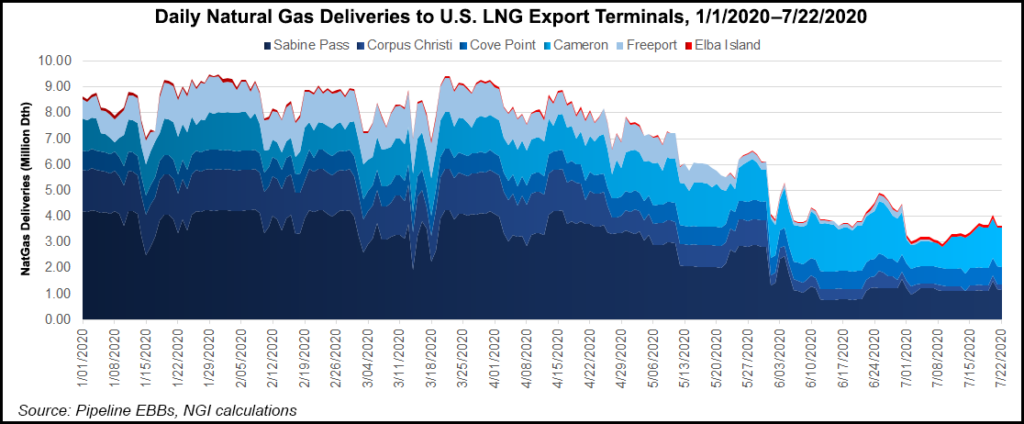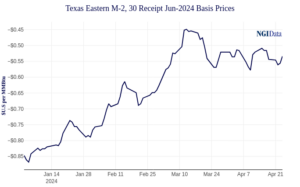LNG | E&P | LNG Insight | NGI All News Access | NGI The Weekly Gas Market Report
Baker Hughes Sees Uptick in Covid-Related Remote Operations, with Longer-Term LNG Outlook Still Positive
Covid-19 has created near-term challenges, but Baker Hughes Co. has seen positives as its remote services capabilities expand to serve customers. In addition, the outlook for global natural gas continues to be solid, CEO Lorenzo Simonelli said Wednesday.

Simonelli shared second quarter results and insight on the opportunities and challenges ahead during a conference call with financial analysts. The pandemic proved a worthy challenger to the Houston-based oilfield services (OFS) giant, as profits plunged and orders fell.
Demand for liquefied natural gas (LNG) equipment, provided by the Turbomachinery and Process Systems (TPS) segment, remains challenging in the near term. However, “we continue to stay optimistic on the longer-term fundamentals for natural gas and especially LNG In the near term.”
Final investment decisions (FID) “remain uncertain given the macroeconomic environment, with the economic impact of Covid-19 putting pressure on LNG demand and driving further weakness in LNG prices. Despite this uncertainty, we expect there could be one or two FIDs by year-end, with smaller or brownfield projects…more competitively advantaged.
“Longer term, we remain firm believers that natural gas and LNG demand growth will outpace oil demand as natural gas will be both a transition and destination fuel as the world looks for cleaner sources of energy in the coming decades.”
Stimulating LNG
Simonelli said there have been “several actions” undertaken during the pandemic that could accelerate the shift to gas from coal and oil, including lower gas prices.
“Furthermore, a number of government pandemic stimulus packages have included requirements for green energy or a focus on energy transition, including LNG,” he said. “For example, clean energy features heavily in the European Commission stimulus package. And in Germany, LNG trucks have been granted toll road exceptions into 2023.”
The European Union earlier this month approved a US$2.8 billion economic recovery plan for all of the member states for 140 transport projects. The funding, to reinforce railways, as well as connections to ports and airports, is designed to help deliver climate objectives set out in the European Green Deal. Among other things, funding would be provided to convert shipping vessels to run on LNG, with corresponding infrastructure installed in ports.
“We see quite a few opportunities across our TPS portfolio, including the introduction of more efficient power generation and compression technology to help minimize carbon emissions for new projects and for our current installed base of LNG equipment,” Simonelli said. Globally, Baker Hughes already has an installed base of more than 400 million metric tons/year of liquefaction equipment.
Near term is a bit tricker to navigate.
“The reinstitution of some lockdowns and the potential for lingering high unemployment create an uncertain economic environment that likely persists through the rest of 2020,” the CEO said. “We are preparing for potential future volatility, while also focusing on both structurally reducing our cost base and implementing a number of strategic initiatives across all of our product companies.”
More quarterly earnings coverage by NGI may be found here.
The bread-and-butter OFS segment is facing a sharp decline in activity worldwide, with North American drilling and completion (D&C) declining more than 50% from the first quarter, in line with expectations.
“We started to see some improvements in our production-related businesses in June and July,” but “visibility over the second half of 2020 remains limited, with any incremental activity closely tied to oil prices,” Simonelli said.
U.S. D&C spend now is forecast to decline by more than half for the entire year, with few gains in international business.
Remote Possibilities
Baker Hughes saw bright spots in the quarter.
“We have seen a solid increase in remote operations so far in 2020,” Simonelli said, “with over 70% of our drilling operations in the second quarter utilizing remote capabilities, up from 60% in the first quarter and roughly 50% in 2019.”
The OFS segment delivered 72% of its global drilling services jobs remotely, compared to 60% in 1Q2020. Remote wireline jobs increased by 13% even with lower activity levels.
Among the milestones, the OFS team remotely drilled an industry first of two miles in a 24-hour period, and it separately drilled 11,253 feet in a 24-hour period for North American customers.
Remote inspection capabilities also improved to support customers facing virus restrictions. Among other things, the OFS segment helped with remote equipment installation, factory acceptance testing and project approvals. The team installed multiple wellheads on two different rigs to remotely support a customer “without incurring any downtime.”
In addition, Baker Hughes assisted supermajor Equinor SA with drilling operations in Norway, where automated remote operations were installed on six rigs to reduce field service personnel by half.
The TPS segment also performed remote work, with more than 50 witness tests and inspections for customers.
“While the majority of our drilling operations are now utilizing remote capabilities, we still see further opportunities for margin improvement, as we are in the relatively early stages of recognizing the full scope of cost and productivity benefits of this technology,” Simonelli said.
“Additionally, we see increased opportunities over time as we apply remote operation capabilities outside of drilling and toward broader well construction and completion-related activities.”
Orders for the quarter came in at nearly $4.9 billion, down 12% sequentially and 25% from a year ago. The sequential decline was a result of lower order intake in OFS, Digital Solutions and TPS, partially offset with strong intake in Oilfield Equipment.
Equipment orders were flat sequentially and service orders were down 19%. The total book-to-bill ratio in 2Q2020 was 1.0; the equipment book-to-bill ratio in the quarter was 1.1.
Revenue decreased 13% sequentially and 21% year/year to $4.7 billion.
Net losses totaled $201 million (minus 31 cents/share) in 2Q2020, compared with a year-ago loss of $9 million (minus 2 cents). Revenue fell 21% to $4.7 billion. Total segment operating income was $221 million, off 39% sequentially and down 52% from 2Q2019.
© 2024 Natural Gas Intelligence. All rights reserved.
ISSN © 1532-1231 | ISSN © 2577-9877 | ISSN © 1532-1266 |


